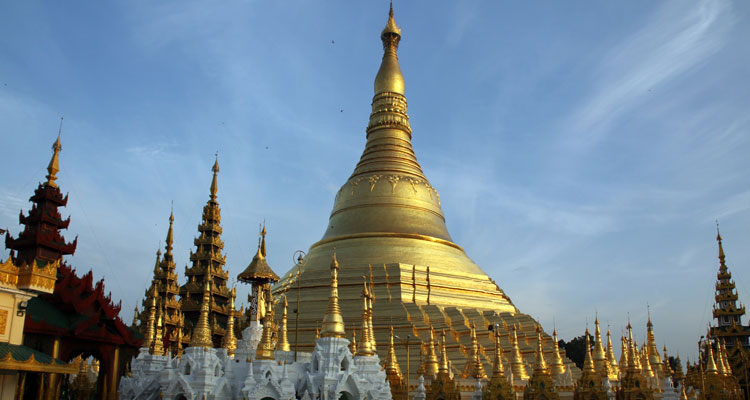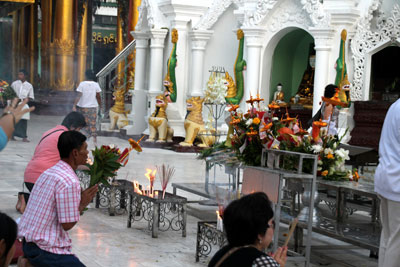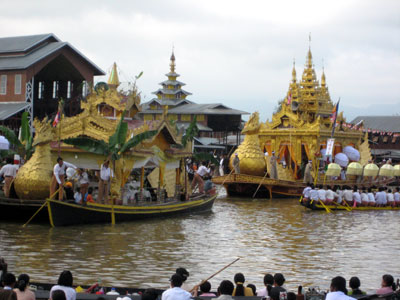Enchanted by the serenity and beauty of Burma
By Fred DeVinney. Photos by Jean DeVinney
Oakland, CA
My wife and I visited Burma (Myanmar) in October of 2010 on a small-group tour sponsored by Original World (Sausalito, CA; 888/367-6147. Before I describe our marvelous trip, the fantastic sights and the beautiful, gentle people, let’s take care of the elephant in the room: the country’s ruthless regime.
That the country has a repressive regime is a fact, but boycotting Burma, I feel, would serve only to deprive the many Burmese employed at the hotels, restaurants and artisan shops of their desperately needed jobs. Yes, some of the money you spend will end up in the coffers of the government, but much will end up in the hands of these lovely people.
We saw no signs of the military, either at the airport or anywhere we went, and we felt comfortable walking everywhere by ourselves. It felt like one of the safest countries we have visited.
Though the military junta imposed the name of Myanmar on the country, it appeared to us that the people not in support of the regime preferred its historical name, Burma.
One item of note — their government is not an appropriate topic of discussion there, and you should never broach the subject with a guide or any Burmese you meet.
Beginning in Yangon
The 12-day tour, which cost $2,950 per person, included all meals, hotels, domestic flights and entrance fees plus a guide and driver. Only one other couple, good friends of ours, joined this particular tour. We chose to arrive a day early, which we do with all trips now, as airlines pretty much go by Murphy’s law.
From Bangkok, Thailand, there are daily direct flights to Yangon (Rangoon). We were met at the airport by “Rosie,” who was our guide for the entire 12 days. She turned out to be a great guide with very good English skills and an intuitive sense of how to pace things for us.
We were taken to the Savoy Hotel and instantly fell in love with this cozy place with friendly staff, comfortable, spacious rooms, two nice restaurants and an atmospheric bar. It had an old British ambiance despite being relatively new.
With an extra day for ourselves, we had some time to relax, but soon we were chomping at the bit. It was only a short walk to the Shwedagon Pagoda, the most sacred of Buddhist sites in Burma.
Fantastic, splendid and breathtaking are just a few of the words that describe this immense, golden, bell-shaped stupa surrounded by temples, shrines and pavilions. At sunset, it was magnificent. It was also a great place to observe the Burmese people, at prayer and socializing.
We returned to Shwedagon, definitely the highlight of Yangon, twice more with Rosie, once for a detailed tour and again, at night, to enjoy the splendor of this marvelous complex bathed in light.
Yangon is where most tours to Burma start, and the city’s National Museum offers a nice introduction to Burmese culture and history.
An interesting walking tour of the city center included the landmark Sule Pagoda and the vast Bogyoke Aung San Market with more than 1,600 shops and the largest selection of Burmese handicrafts available anywhere.
As “only mad dogs and Englishmen go out in the midday sun,” we blended our sightseeing with some R&R at the Savoy’s large pool.
Late one afternoon we decided to walk around picturesque Kadawgyi Lake, offering a view of Shwedagon, unwisely ignoring a pitch-black sky in the distance. Halfway around, all hell broke loose and our small umbrellas were almost useless. It was actually quite funny as we finally hailed a cab and arrived back at the Savoy looking like a couple of drowned rats.
Donning dry clothes, we wrapped up our visit to Yangon with a nice dinner in the hotel’s Italian restaurant, the more casual of the hotel’s two restaurants.
Bagan
We moved on with a short flight to Bagan, a small town on the eastern bank of the Irrawaddy River and, from the 11th to 13th centuries, the site of the capital of the first Burmese Empire. It has been said to rival Angkor Wat as Southeast Asia’s most memorable sight.
Over 4,400 temples and pagodas were built there, over half of which are still visible, spread out over 16 square miles. At first we thought four days there might be too much time, but the extra days allowed us to relax and enjoy this vast area a little at a time, with afternoon breaks on three of the days at the pool of the very nice Bagan Thande Hotel. Our pleasant room there, with a balcony overlooking the Irrawaddy, allowed us to observe life along the river.
Late on our first afternoon, we climbed to the Mingalazedi Pagoda to look out over the sea of surrounding pagodas and stupas at sunset — a truly splendid sight and a great introduction to Bagan. It was fortunate that we did this, as a much-anticipated balloon trip over this vast complex was canceled two mornings in a row due to rain.
The ride ($275 each) was paid for in advance, but there was no problem getting a quick refund. It was disappointing, but we were told that they often have to cancel this excursion.
During our four days in Bagan we visited an amazing variety of temples and pagodas, many with superb Buddhist statues, art and murals. We also had the opportunity to visit a school, bringing gifts of school supplies that we purchased in Bagan.
A visit to a lacquerware factory was quite interesting and offered a good chance to pick up a few gifts.
Evenings out
On our third day we traveled through countryside villages to Mt. Popa, where, atop a rocky, 2,300-foot-high outcrop, there was a picturesque complex of temples. We started the long climb to the top under a covered walkway, but a sudden rain made the steps too slippery to continue, so we retreated to the Popa Mountain Resort for lunch. As the clouds lifted, the view back to the Mt. Popa temple complex was spectacular.
Our final day was highlighted with a climb to another temple for a “balloon’s-eye” view followed by a late-afternoon cruise down the Irrawaddy.
Rosie imparted a wealth of information throughout and also provided some great evening experiences, two of the more memorable taking place in Bagan.
Marionette performances, with large, colorful puppets, is a primary art form in Burma. We attended a dinner show that was outstanding.
On another night we attended a performance of traditional dance, plus dinner, at a splendid outdoor restaurant with a number of temples lit up in the background. Pretty awesome!
Throughout our trip, Rosie did a great job of picking varied restaurants, often in lovely outdoor settings, mixing Burmese, Thai and Chinese cuisines. However, she surprised us one day at lunch when she said, “I think you are ready for American food.”
We stopped at a nice garden restaurant and, after careful perusal of the menu, we all chose cheeseburgers, which we asked to be smothered in fried onions. It took the waiter three discussions with Rosie to realize that these crazy Americans just wanted stir-fried onions — not battered, not with mixed vegetables, not with sauce but just plain old fried onions.
Although we had many very good meals of various Asian dishes that Rosie would order for us, we sometimes opted for lighter à la carte Western meals, particularly in the evenings at our hotel when a special event was not planned.
Mandalay and beyond
Our third stop was Mandalay, where we stayed at the Sedona Hotel, a very nice, modern hotel in the center of town. Although we slipped in a quick swim upon arrival, we spent most of our two-plus busy days there seeing the sights.
Particularly memorable was our visit to the Mahagandayon Monastery, where hundreds of Buddhist monks stream in each morning with their rice bowls for their main meal of the day. We were able to watch this colorful proceeding from a balcony with an intimate perspective.
Another great experience was a walk across the almost-mile-long, teak U Bein Bridge over Taungthaman Lake, the area filled with locals enjoying a Sunday outing. A gondola ride back gave us another nice perspective.
A trip into the Sagaing hills, dotted with stupas and pagodas, offered marvelous views of the Irrawaddy River and Mandalay.
We went up to Mandalay Hill for the sunset on our final evening. With its huge standing Buddha and sweeping view of the city, it was a nice place to end our visit to Mandalay.
A short flight took us to Inle Lake and the Phaung Daw U festival, held each October. Our trip was timed to take in the last two days of this colorful event.
Upon arrival, we took a scenic half-hour boat ride to our hotel, the wonderful Inle Princess Resort, where we had a nicely decorated cottage with a deck right on the edge of the lake. The resort is set among beautiful gardens and waterways and includes a splendid main lodge and dining room.
Though we were to travel the next two days by small motorboats, Inle Lake is famous for the one-legged rowers. Standing on small fishing boats, these men wrap one arm and a leg around an oar to row, which leaves the other arm free to handle their fishing nets.
While traveling around the lake, we enjoyed visits to small villages plus a stop to see the unique Padaung women, their necks stretched by layers of golden rings.
Thousands of Burmese attend the Phaung Daw U festival each year, the festival’s final two days providing the highlight. A large, elaborate, golden royal boat carries statues of Buddha from village to village, returning on the final day to a splendid pagoda where the statues are ceremoniously retired.
We arrived early for a great view of all the proceedings. An entourage of hundreds of colorful boats carrying leg rowers, musicians, dancers and local Burmese added immensely to this colorful finale.
After the Buddha statues were retired, the festival ended with races between the one-legged rowers, with as many as 50 rowers standing on each boat. The Burmese came in large numbers to enthusiastically cheer on their favorites. It was a great ending to a wonderful trip.



